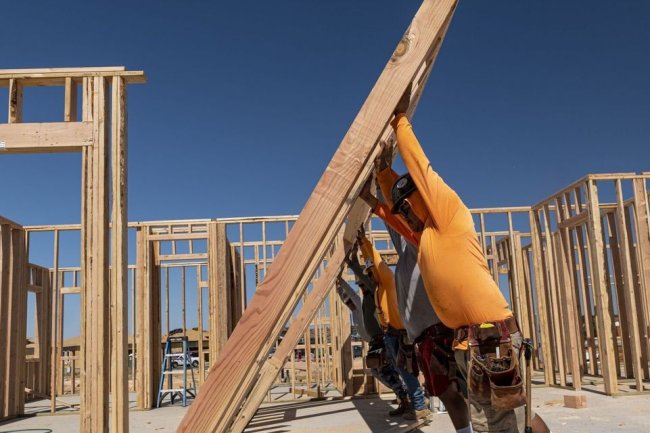From Moby Dick to Wind Farms: East Coast Tries to Pivot Centuries-Old Ports
Turbine parts arrive in New London and New Bedford as future projects deal with surging costs A delivery of offshore wind turbine components arrived in June at the Connecticut State Pier in New London. Kayana Szymczak for The Wall Street Journal Kayana Szymczak for The Wall Street Journal By Jimmy Vielkind and Jon Kamp July 23, 2023 11:00 am ET NEW LONDON, Conn.—The boats tied up at Gary Yerman’s dock in this seaside city have long trawled for scallops and squid. But they have recently been used for something else, too: scouting and security work for a trio of wind farms under development several dozen miles off the coast. This ci


NEW LONDON, Conn.—The boats tied up at Gary Yerman’s dock in this seaside city have long trawled for scallops and squid. But they have recently been used for something else, too: scouting and security work for a trio of wind farms under development several dozen miles off the coast.
This city of roughly 28,000 residents represents a rebirth in some Northeast ports, the beneficiaries of aggressive clean-energy goals in the region that are creating the first commercial offshore wind construction sites in the nation. Before the wind farms’ megawatts reach the grid, the projects are already transforming cities such as New London, Conn., and New Bedford, Mass., once best known for their whaling fleets in the era of Moby Dick.
The 73-year-old Yerman, who has worked in commercial fishing for 50 years, can see yellow tower cranes unloading big steel pieces from his desk. They were shipped in from Scandinavia to form 12 turbines for South Fork, a 132-megawatt project east of Long Island. Officials say that this is the busiest the century-old State Pier has been in years, following a $300 million upgrade.
“A few years ago, it really wasn’t on my radar at all,” Yerman said.

Gary Yerman, Jack Tibbens and Charles Raye unload a catch of fish at the New London Seafood Distributors dock in June.
Photo: Kayana Szymczak for The Wall Street Journal)
Dozens of people will be employed here bolting together tower sections that will then be anchored offshore, company officials said. Engineers filled in 7 acres between two finger piers to create a reinforced space to lay them down. Mayor Michael Passero, a Democrat, said he hoped people will come to watch towers longer than a football field be loaded onto installation ships.
“It will be sort of like a rocket launch down in Cape Canaveral,” said Passero, leader of the city that is home to the U.S. Coast Guard Academy.
This wind-energy transformation has been turbulent at times, and the boom the ports are betting on is far from assured. Many fishermen have objected to anchoring turbines to the ocean floor in East Coast fishing grounds—and still fear for their livelihoods—though some have found added work aiding the new developments. Developers behind several wind farms slated to use these ports say they need to renegotiate power-sales contracts to cover soaring costs. This month, the largest utility in Rhode Island walked away from a proposed 884-megawatt project after determining the required subsidies were too expensive for customers to bear.
And some Republican officials have questioned whether public subsidies for wind, including the port face-lifts, are worth it.
“If the future of the State Pier is to be built up as a major cargo hub for decades, it makes sense. If it’s just to build out a few wind farms and then have a behemoth that nobody’s using, perhaps less so,” said GOP state Rep. Holly Cheeseman, who grew up in New London and represents nearby suburbs.

Workers load and unload wind turbine parts at the State Pier in New London, Conn.
Photo: Jimmy Vielkind/The Wall Street Journal

Sections of wind turbine towers are laid down in the marshaling area at the State Pier in New London.
Photo: Jimmy Vielkind/The Wall Street Journal
The cost of the pier upgrades in New London grew from an estimated $93 million in 2019 to more than $300 million—about $200 million of which is coming from the state and roughly $100 million from developer Ørsted.
The Biden administration has set ambitious offshore wind goals and expanded leasing to the Pacific and Gulf coasts. There are more than 40,000 megawatts of offshore wind in the pipeline, according to a 2022 federal report. The report projected the need for at least five ports to construct the first 10,000 megawatts developed off the Atlantic coast.
More than $1 billion of public and private investment has already been announced, including the $300 million spent in New London. In Brooklyn, N.Y., officials hope to start construction next year on a $287 million port upgrade. New Jersey officials are spending $540 million on a purpose-built wind port near the mouth of the Delaware River. Wind-related investments to the harbor in New Bedford total $284 million.
Each of these facilities will focus on marshaling tower components before they are assembled at sea. Various parts of the turbines are being manufactured in other ports, including ones in Providence and as far away as upstate New York.
In New Bedford, which remains a busy fishing port, giant wind-turbine components including blades are stacked on shore before they are built into the 62-turbine Vineyard Wind project south of Martha’s Vineyard.
Democratic Mayor Jon Mitchell estimated the city has converted 50 or 60 acres of land along the waterfront to service the wind industry, including a $133 million state-funded terminal for staging wind equipment.
“We’re this seafaring city that has lost its manufacturing base, and this is a maritime industry in which we’ve got advantages,” the mayor said.

Giant wind turbine blades for the Vineyard Winds project are stacked on racks in the harbor in New Bedford, Mass.
Photo: Charles Krupa/Associated Press
Planned wind farms slated to use the New Bedford port and an additional port planned in Salem, Mass., recently ran into problems as developers said surging costs and supply-chain issues, caused in part by the Russian invasion of Ukraine, made contracts to sell future wind power to local utilities unworkable.
Developers across the region are trying to work around rising costs. Developer Avangrid recently agreed to pay a $48 million penalty to sever power-purchase contracts with three Massachusetts utilities for a future Salem-based wind farm. This will free up the company—if a state utility regulator agrees—to pursue a more favorable deal through a coming state-bidding process for offshore wind.
Massachusetts state Rep. Jeffrey Roy, a Democrat who chairs a legislative committee covering energy, said he expects cost concerns and broken contracts to delay these wind farms. Regarding expected new bids, Roy said, “If we see slight increases in costs and we can proceed, then I think we’ll be in good shape.”
Mitchell, New Bedford’s mayor, expects a lull for his port once the current wind project is built out, but said the city is also developing to service and operate wind farms, which is steadier work.
Connecticut Port Authority Chairman David Kooris, whose agency led the pier redevelopment, said he was confident the pipeline of projects would provide consistent work in the area to justify the New London investment. The State Pier was processing lumber and road salt before its rehabilitation and was underused, he said.
“We’re going to punch above our weight,” Kooris said.

A local resident fishes along New London City Pier in June.
Photo: Kayana Szymczak for The Wall Street Journal
A total of 60 to 80 people will work assembling towers and building a second heavy-lift berth at State Pier this summer. In coming years, on the larger projects, it will be 80 to 120 people, he said.
The transformation remains uncomfortable for some. Joseph Gilbert, who operates a fleet of four trawlers in nearby Stonington, Conn., said he believes it will be essentially impossible to tow nets or rakes through the fields of turbines.
“Basically, they’re buying the ocean a nibble at a time,” he said.
Yerman had misgivings, but he was convinced after traveling to Northern Ireland to see how fishermen there were able to adapt to new wind farms.
“I looked at offshore wind as an opportunity for commercial fishermen to get money other than fish,” he said.
SHARE YOUR THOUGHTS
What do you think the future holds for the offshore wind industry? Join the conversation below.
Write to Jimmy Vielkind at [email protected] and Jon Kamp at [email protected]
What's Your Reaction?













